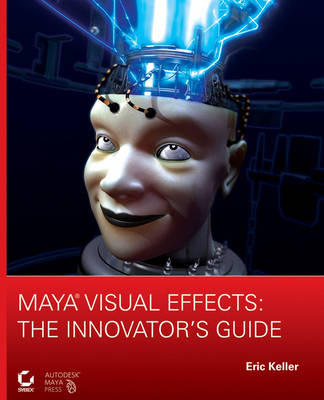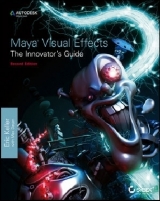
Maya Visual Effects
John Wiley & Sons Ltd (Verlag)
978-0-470-11133-8 (ISBN)
- Titel ist leider vergriffen;
keine Neuauflage - Artikel merken
Create positively dazzling effects with the unique insights and practical advice in this innovative guide from a working professional Maya artist. Need to create plasmatic energy by lunch? Animate a field of sprouting daisies before tomorrow's meeting? Fashion a force field by Friday? With Maya's flexible toolset and the unique tutorials in this book, you'll learn how to solve real-world problems, improvise, and finish your professional assignments on time and with flair.
Eric Keller has been using Autodesk's Maya to create professional animations since version 1 was released and has been an enthusiast ever since. He is currently a high-end animator for film, television, and scientific visualization. His clients include Disney, ESPN, Hewlett-Packard, CBS, and ABC. Prior to that, he created animations for some of the world's top researchers at the Howard Hughes Medical Institute. He was a contributing author to Mastering Maya 7 and Mastering Maya 8.5 (Sybex).
Introduction. Chapter 1 Texture Effects. Creating Animated Lighting Effects with Ramp Textures. Creating the Light Geometry. Shading the Lights. Creating Glowing Lights. Shading the UFO Dome. Streaking Energy Effects. Know Your Glows. Creating the Energy Geometry. Creating a Mask with a Second Ramp. Connecting the Ramp to the Motion Path Output Value. Reconnecting the Energy Shader. Layering with Multiple UV Sets: The Zombie's Hand. Creating Multiple UV Sets. Creating the Mask for the Spreading Infection. Creating a Splotch. Bringing the Color Back. Abusing Ambient Occlusion: The Sci Fi Scanner. Creating the Scanner Shader. Tuning the Shader. Controlling Particles with Textures: Swimming Bacteria. Creating the Particle and Goals. Creating the Ramps. Adjusting the Ramps. Chapter 2 Particle Effects. Particle Instancing and Expressions: Creating a 3D Audio Meter. Using the Instancer. Animating the Meter. Duplicating the Meter. Particle Collisions: The Classic Force Field Effect. Creating the Force Field. Creating the Look of the Shield. Ray Gun Impact Effect. Editing the Instances. Animating the Force Field. Instancing with Paint Effects: Pushing Up the Daisies. Setting Up Collisions. Creating the Flower. Creating the Flower Object Cycle. Controlling the Growth with Expressions. Using Cycle Emission: The Plasma Ball. Creating the Plasma Emitter. Cycle Emission. Containing the Particles. Collision Events. The Secondary Particles. Polishing the Plasma. Influencing Cameras with Particles. Creating the Particle Rig. Adding Dynamic Motion to the Particles. Attaching the Camera to the Particle Rig. Tuning the Motion. Creating the Blood. Creating the Blood Cell Rotation. Chapter 3 Rigging for Effects. The Vibrating Rig: Making a Tentacle Shake. Disconnecting the Animated Rig. Creating a Vibrating Joint. Duplicating the Vibrating Joint. Adding the Shakers to the Rig. Reconnecting the Tentacle. Controlling the Vibration. Inverse Kinematic Splines: Making a Tentacle Climb. Drawing the Main Tentacle Curve. Adding Joints to the Curve. Animating the Curve. Adjusting the Animation. Creating Joints for the Tentacle. Activating the IK Spline Tool. Animating the IK Spline Offset. Joints and Constraints: The Telescopic Car Suspension Rig. Creating the Telescoping Leg. Creating the Telescopic Rig. Setting Limits for the Scale X Attribute. Creating an IK Handle for the Leg Joints. Creating an Automated Scaling Control. Duplicating the Leg Rig. Placing the Legs. Constraining the Wheels. Creating Front and Rear Controls. Making the Car Move. The Inverse Kinematic Spline Tool and Lattices. Setting Up the Lattice. Adding Joints to the Lattice. Adding an IK Spline to the Joints. Animating the Squashing Effect. Creating a Twist. Chapter 4 Creative Blend Shape Use. Blend Shapes and Lattices. Revolving a Surface. Creating a Blend Shape for the Profile Curve. Setting Up a Control View Camera. Setting Up Blend Shape Controls. Making the Vase Spin. Animating the Sculpting of the Vase. Deforming the Blend Shape Lattice with Joints. Blend Shape In-Betweens. Working with Blend Shape Targets. Painting Blend Shape Weights. Creating the Blend Shape Sequence. Adjusting the Animation. Rigging the Pod. Animating the Pod. Animating the Eyes. Creating the Time Lapse Effect. Interactive Blend Shape Rigs. Creating the Blend Shape. Creating the Interactive Control. Duplicating the Rig. Editing the Animation. Creating an Animated Array of Bricks. Having Fun. Layering Blend Shapes. Creating the Blend Shapes. Animating the Blend Shape with Fractal Textures. Creating Controls for the Textures. Animating the Blend Shape Transformation. Chapter 5 Paint Effects. Paint Effects and Toon Lines: The Mine Detector Display. Creating the Probe and Mine Display. Creating the Proximity Warning Display. Adding Paint Effects Strokes to the Proximity Display. Adding Interactive Control to the Proximity Display. Using the Information from the Distance Between Node. Duplicating the Mines. Animating the Probe. Illuminating the Path. Animating the Path. Finishing Touches. Hallucinations in 3D: Using the Smear Stroke. Adjusting the Tree. Animating the Tree. Framing the Scene. Lighting the Scene. Using a Smear Brush. Tuning the Brush. Animating the Tubes. Variation Number One. Variation Number Two. Variation Number Three. Paint Effects Strokes and Soft Body Dynamics. Animating the Movement of the Bacterium. Creating the Soft Body Object. Creating Bacterial Pili with Paint Effects. Modifying the Weeds Stroke. Editing Surface Offset. Animating the Bacterial Pili. Converting Paint Effects to NURBS. Playblast the Animation. Taming Paint Effects Brush Strokes: The Test Tube Nerve. Creating the Nerve Using Paint Effects. Adjusting the Look of the Nerve Stroke. Adjusting Branches and Twigs. Adjusting Forces. Creating a Control Curve. Animating the Control Curve. Converting the Control Curve to a Soft Body Object. Editing the Goal Weights of the Soft Body Curve. Controlling the Growth for the Stroke. Key Framing Stroke Growth. Rendering the Nerve. Chapter 6 Soft Body Springs. Soft Body Springs and Geometry: Simulating Magic. Creating the Magical Field Geometry. Converting the Cube into a Soft Body Object. Adding Fields to the Soft Body Object. Distorting the Magic Field with a Secondary Particle System. Adding a Radial Field to the Distorter Particles. Adding Soft Body Springs to the Particles. Setting Initial State. Rendering the Magical Field. Creating a Glowing Edge on the Magical Force Field. Soft Body Springs and Particles. Creating the Emitters. Attaching Springs to the Particles. Adjusting the Simulation. Adding a Turbulence Field. Using the Particle Object as a Paintbrush. Setting the Attributes for the paintSprites. Creating Particle Sprites. Adding Custom Attributes for the Sprites. Adding Images to the Sprites. Assigning the Images to the Sprites. Rendering the Animation. Chapter 7 Rigid Body Effects. Rigid and Soft Body Combinations: Dynamic Dents. Preparing the Models for Dynamic Interaction. Creating the Collision Simulation. Adjusting the Simulation. Denting a Surface Using Soft Body Dynamics. Adding Springs to the Soft Body Object. Baking the Rigid Bodies. Finishing the Scene. Creating Animated Fissures on a Surface. Boolean Operations. Modeling the Fissure. Animating the Fissure. Preparing the Scene for Dynamics. Separating the Pieces of the Crystal. Creating Rigid Bodies from the Separate Pieces. Applying Gravity to the Active Rigid Body. Adjusting the Dynamics. Keyframing the Dynamics. Keyframing the Visibility of the Chunks. Rigid Body Spring Constraints. Creating the Text. Renaming the Letters Using MEL. Creating the Spring Constraint. Adjusting the Spring Constraint. Automating the Spring Rig Creation Using MEL. Creating a Shelf Button from the Script. Completing the Logo Rig. Animating the Logo. Offsetting the Driven Keys. Finishing the Animation. Chapter 8 Hair and Fur Effects. Maya Hair: Using Dynamic Curves to Animate a Rope Bridge. Creating the Ropes for the Bridge. Converting the Curves to Dynamic Curves. Animating the Rope Cut. Creating a Hair Constraint. Attaching the Stick Constraint to the Second Rope. Creating a Plank for the Bridge. Attaching the Plank to the Ropes. Creating Multiple Hair Constraints. Animating the Bridge. Finishing Touches. Creating a Cache for the Dynamic Curve. Maya Fur: The Miracle Lawn. Creating Ramps for the Animated Textures. Animating the Ramps. Rendering the Ramps. Creating the Lawn. Adding Grass to the Lawn. Adjusting the Grass Settings. Animating the Length of the Grass. Baking the Length Channel. Animating the Color of the Lawn. Index.
| Erscheint lt. Verlag | 27.3.2007 |
|---|---|
| Verlagsort | Chichester |
| Sprache | englisch |
| Maße | 205 x 255 mm |
| Gewicht | 1038 g |
| Einbandart | Paperback |
| Themenwelt | Informatik ► Grafik / Design ► Film- / Video-Bearbeitung |
| Informatik ► Grafik / Design ► Maya | |
| ISBN-10 | 0-470-11133-X / 047011133X |
| ISBN-13 | 978-0-470-11133-8 / 9780470111338 |
| Zustand | Neuware |
| Informationen gemäß Produktsicherheitsverordnung (GPSR) | |
| Haben Sie eine Frage zum Produkt? |
aus dem Bereich



